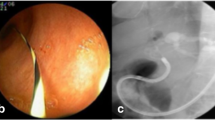Abstract
Background
Recently, a digital single-operator cholangiopancreatoscope (DSOC) has become available. This system allows the performance of electrohydraulic lithotripsy (EHL) even within the main pancreatic duct (MPD). However, there are only few reports of EHL for MPD stones using SPY-DS.
Aims
The aim of this study was to evaluate the technical feasibility and efficacy of EHL for MPD stones under DSOC guidance.
Methods
Between October 2016 and August 2017, patients with MPD stones were retrospectively enrolled in this study. The presence of MPD stones was diagnosed by endoscopic ultrasound and MRCP. The patients’ baseline characteristics and those of the stones, including their size, number, and site in the MPD, number of EHL procedures, and adverse events, were reviewed.
Results
A total of 21 patients were retrospectively enrolled. The etiologies of chronic pancreatitis were idiopathic (n = 4) and alcohol induced (n = 17). The pancreatic stone was variously located in the head (n = 6), body (n = 11), tail (n = 1), head and body (n = 2), and body and tail (n = 1) of the pancreas. Median pancreatic stone size was 12 mm, and the mean number of ERCP sessions was 1.29 (range 1–3). EHL was successfully performed in 15 patients (85.7%, 18/21), and the rate of complete stone clearance was 88.2% (18/21). Severe adverse events were not seen in any of the patients, although one patient developed mild acute pancreatitis.
Conclusions
In conclusion, although additional case reports and prospective studies are needed, EHL under DSOC may be an option to treat MPD stones.



Similar content being viewed by others
References
Majumder S, Chari ST. Chronic pancreatitis. Lancet. 2016;387:1957–1966.
Yadav D, Timmons L, Benson JT, et al. Incidence, prevalence, and survival of chronic pancreatitis: A population-based study. Am J Gastroenterol. 2011;106:2192–2199.
Ogura T, Imanishi M, Kurisu Y et al. Prospective evaluation of digital single-operator cholangioscope diagnostic and therapeutic procedures (with videos). Dig Endosc 2017 [Epub ahead of print].
Tanaka R, Itoi T, Honjo M, et al. New digital cholangiopancreatoscopy for diagnosis and therapy of pancreaticobiliary diseases (with videos). J Hepatobiliary Pancreat Sci. 2016;23:220–226.
Navaneethan U, Hasan MK, Kommaraju K, et al. Digital, single-operator cholangiopancreatoscopy in the diagnosis and management of pancreatobiliary disorders: a multicenter clinical experience. Gastrointest Endosc. 2016;84:649–655.
Bekkali NL, Murray S, Johnson GJ, et al. Pancreatoscopy-directed electrohydraulic lithotripsy for pancreatic stones in painful chronic pancreatitis using spyglass. Pnacreas. 2017;46:528–530.
Trikudanathan G, Freeman ML. Electrohydraulic lithotripsy of large pancreatic duct stones by using digital pancreatoscopy. Gastrointest Endosc. 2016;83:1285–1296.
Inui K, Igarashi Y, Irisawa A, et al. Japanese clinical guidelines for endoscopic treartment of pancreatolithiasis. Pancreas. 2015;44:1053–1064.
Cotton PB, Eisen GM, Aabakken L, et al. A lexicon for endoscopic adverse events: Report of an ASGE workshop. Gastrointest Endosc. 2010;71:746–754.
Dite P, Ruzicka M, Zboril V, et al. A prospective, randomized trial comparing endoscopic and surgical therapy for chronic pancreatitis. Endoscopy. 2003;35:553–558.
Cahen DL, Gouma DJ, Nio Y, et al. Endoscopic versus surgical drainage of the pancreatic duct in chronic pancreatitis. N Engl J Med. 2007;356:676–684.
Nguyen-Tang T, Dumonceau JM. Endoscopic treatment in chronic pancreatitis, timing, duration and type of intervention. Best Pract Res Clin Gastroenterol. 2010;24:281–298.
Moole H, Jaeger A, Bechtold ML, et al. Success of extracorporeal shock wave lithotripsy in chronic calcific pancreatitis management: A meta-analysis and systematic review. Pancreas. 2016;45:651–658.
Ohara H, Hoshino M, Hayakawa T, et al. Single application extracorporeal shock wave lithotripsy is the first choice for patients with pancreatic duct stones. Am J Gastroenterol. 1996;91:1388–1394.
Inui K, Tazuma S, Yamaguchi T, et al. Treatment of pancreatic stones with extracorporeal shock wave lithotripsy: results of a multicenter survey. Pancreas. 2005;30:26–30.
Dumonceau JM, Costamagna G, Tringali A, et al. Treatment for painful calcified chronic pancreatitis: extracorporeal shock wave lithotripsy versus endoscopic treatment: a randomized controlled trial. Gut. 2007;56:545–552.
Attwell AR, Brauer BC, Chen YK, et al. Endoscopic retrograde cholangiopancreatography using endoscope and catheter-based pancreatoscopes: A 10-year single-center experience. Pancreas. 2014;43:268–274.
Attwell AR, Patel S, Kahaleh M, et al. ERCP with per-oral pancreatoscopy-guided laser lithotripsy for calcific chronic pancreatitis: a multicenter U.S. experience. Gastrointest Endosc. 2015;82:311–331.
Author information
Authors and Affiliations
Contributions
Takeshi Ogura wrote a paper. Takeshi Ogura, Atsushi Okuda, Miyuki Imanishi, Akira Miyano, Mio Amano, Nobu Nishioka, Rieko Kamiyama, and Kazuhide Higuchi played roles of interpretation of data for the work, revising it critically for important intellectual content, final approval of the version to be published, agreement to be accountable for all aspects of the work in ensuring that questions related to the accuracy or integrity of any part of the work are appropriately investigated and resolved.
Corresponding author
Ethics declarations
Conflict of interest
The authors declare that they have no conflicts of interest.
Electronic supplementary material
Below is the link to the electronic supplementary material.
Supplementary material 1: Endoscopic lithotripsy was performed under SPY-DS guidance, resulting in successful fragmentation of the stone. (AVI 14513 kb)
Rights and permissions
About this article
Cite this article
Ogura, T., Okuda, A., Imanishi, M. et al. Electrohydraulic Lithotripsy for Pancreatic Duct Stones Under Digital Single-Operator Pancreatoscopy (with Video). Dig Dis Sci 64, 1377–1382 (2019). https://doi.org/10.1007/s10620-018-5374-z
Received:
Accepted:
Published:
Issue Date:
DOI: https://doi.org/10.1007/s10620-018-5374-z




